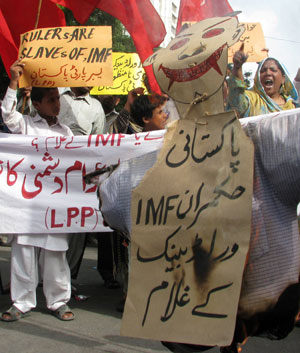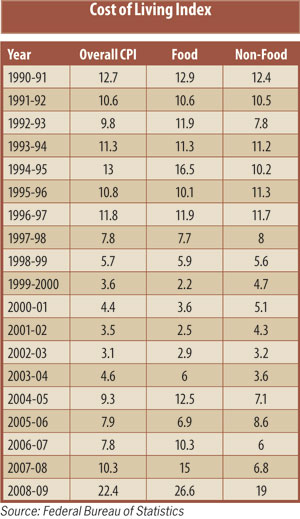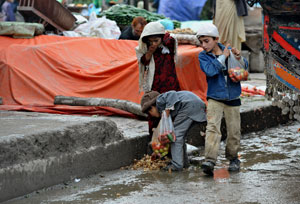Tied to the Donors
By Shahid-ur Rehman | Business | News & Politics | Published 15 years ago
Finance Minister Hafeez Shaikh is faced with a “mission impossible.” He has the arduous task of having to convince the people of Pakistan about TINA, “There Is No Alternative” to the RGST (Reformed General Sales Tax). Having tried his hand at it twice, albeit only partially successfully — when he argued that the RGST was needed to repay the IMF (International Monetary Fund) loans, and that Pakistan would not be able to pay the salaries of government employees if IMF tranches were not disbursed — the finance minister and his colleagues have recently peddled a host of other arguments. They argue that the RGST is not a new tax and that it is needed to document the economy. They say it would also enhance the country’s tax-to-GDP ratio. However, the long and short of the RGST is that its levy would secure the remaining $3.4 billion out of $11.3 standby loans and that, in turn, would help us negotiate another loan. Failure to get the IMF nod would not only mean the loss of the amount due from the IMF, it would also jeopardise disbursement of loans from international financial institutions.
Since 1988, Pakistan has concluded four packages with the IMF. A bird’s-eye view of these packages would help understand the economic quagmire in which Pakistan is currently bogged down (see “Package Deal”).
After 20 years of IMF-World Bank dictated programmes, Pakistan’s dependence on foreign aid has grown to such an extent that today it is being kept afloat by donors and international financial institutions. Shaikh has made it known that when the current package with IMF lapses in December 2010, extendable to March 2011, the government would like to negotiate another package with the IMF. This would mean betrothing Pakistan to an IMF package for a quarter of a century.

Anger against the IMF runs high in Pakistan. Photo: AFP
Ever since its birth in 1947, prophets of doom have made predictions about the viability of Pakistan, and their voices became louder after the separation of East Pakistan in 1971. During the 1990s, such predictions were fuelled when Pakistan was ranked the second most corrupt country in the world. Termination of US aid in August 1990, revealed that Pakistan was being kept afloat by outside help.
During recent weeks, there has been a plethora of reports such as “Pakistan economy on the verge of collapse,” “What went wrong?” “Is the country headed for a point of no return?” and “The meltdown has begun.” Statistics and articles are increasingly documenting the number of people falling below the poverty line, poor governance, rising incidence of corruption, breakdown of utilities, law and order and regional disparities. Pakistan’s biggest federating unit in the south is in revolt, the state is at war with its own people in the north, its green passport holders are treated as untouchables and non-resident Pakistanis returning from a visit abroad are treated as suspected terrorists. Two-digit galloping inflation, nepotism, black marketing and breakdown of law and order is the order of the day. One could go on listing the ailments from which Pakistan’s economy is suffering, but the most distinct of them on the economic front are the national debt, the circular debt and power shortages.
Pakistan’s domestic and external debt is the cumulative result of living beyond our means for 60 years. In the year 2010, the federal government is borrowing at a rate of Rs 1.5 billion every day. In 2001, when a former World Bank vice-president Dr Pervez Hassan submitted a Debt Retirement Strategy, former finance minister Sartaj Aziz had called it “a borrow-more-to-retire” debt strategy. Commenting on the strategy, then World Bank resident representative John Wall had aptly said: “Pakistan is in a hole and still digging.” The debt quagmire is becoming inextricable.
In 2006, in my book, Pakistan Sovereignty Lost — a history of how Pakistan was bogged down in the debt trap — I wrote that Shaukat Aziz would go down in Pakistan’s history as the prime minister under whom external debt snowballed, while the government trumpeted claims of reducing the size of the external debt. That prediction is coming true in 2010 as reflected by Finance Minister Hafeez Shaikh’s statements.
The finance minister’s claims that without the RGST Pakistan would not be able to repay IMF loans, calls for soul-searching rather than going ahead with the stopgap arrangements that have been tried time and again in the last 20 years. The million-dollar question posed to the finance minister and his office should be, what has happened to more than 100 billion dollars in aid and almost an equal amount in grants, if Pakistan cannot repay even $5 billion per annum? It also speaks volumes about the utility of foreign aid.
Pakistan has repaid at least $55 billion, including the principal amount and interest to-date, and has an outstanding external debt of $55 billion. But in actual fact the total external debt is much larger than the official figures. It was brought down artificially through a trick by Shaukat Aziz’s government when former Economic Advisor Dr Ashfaq Hassan innovated a new term called “contingency liabilities.” A whole new chapter of contingency liabilities was added to the Economic Survey in 2001.
 Contingency liabilities mainly relate to sovereign guarantees that Pakistan has extended to 25 independent power producers producing 7,600 MW of electricity and created a major fiscal anomaly whereby contingency liabilities do not form part of the national debt, but are being paid for by the government. The fact that the figures of total debt and debt repayments might be under-invoiced was conceded by the Economic Survey for 2009-10, when it observed that “reported debt levels of a sovereign may be understated owing to the non-inclusion of guarantees, explicit or implicit, which may materialise in future.” The fiscal mess created by these liabilities could be gauged from the mere fact that nearly one trillion rupees have been paid in the last seven years.
Contingency liabilities mainly relate to sovereign guarantees that Pakistan has extended to 25 independent power producers producing 7,600 MW of electricity and created a major fiscal anomaly whereby contingency liabilities do not form part of the national debt, but are being paid for by the government. The fact that the figures of total debt and debt repayments might be under-invoiced was conceded by the Economic Survey for 2009-10, when it observed that “reported debt levels of a sovereign may be understated owing to the non-inclusion of guarantees, explicit or implicit, which may materialise in future.” The fiscal mess created by these liabilities could be gauged from the mere fact that nearly one trillion rupees have been paid in the last seven years.
It is intriguing that neither any government functionary nor international financial institutions view snowballing payments to IPPs (Independent Power Projects) as a concern, because in this sector interests of the profit-making foreigners, corrupt politicians and bureaucracy concur. The million-dollar question remains — why have WAPDA or government sectors not set up a single project? The PPP manifesto of 2002 states that IMF-World Bank conditionalities have tied down Pakistan to IPPs.
Circular debt is Pakistan’s biggest and most immediate budgetary problem. As is evident from its nomenclature, circular debt has been created by dues and receivables that several oil, gas and power related companies owe to each other. Like the proverbial vicious circle of poverty, the “circular debt” is breeding and feeding itself. In this vicious circle, oil and gas companies (Pakistan State Oil, Sui Northern Gas Pipeline, Sui Southern Gas Company), refineries (Attock Oil Company, National Refinery and Pakistan Refinery) PEPCO and WAPDA, their subsidiary distribution companies as well as major IPPs like HUBCO and KAPCO owe hundreds of billions of rupees to each other.
The government had inherited a huge backlog of circular debt when it came into power in late 2008, because Shaukat Aziz and company deliberately delayed adjustments resulting from rising oil prices. The government parked a circular debt of Rs 300 billion in a holding company, and has been unable to meet even its interest obligations of Rs 40 billion per annum. Thus, Rs 40 billion is being added to the circular debt merely on account of interest charges. The cumulative circular debt has risen to Rs 584 billion and was expected to touch Rs 781 billion by the end of the current fiscal year.
A story by The News reporter Mansoor Ahmad, in November revealed that “the finance ministry, in its presentation to the World Bank at the start of this fiscal year, conceded that another Rs 225 billion were added to the circular debt by end June (2010). It was also projected that by the end of the current fiscal year, a further Rs 256 billion would be added to the circular debt at an average of Rs 21.33 billion per month.”
Since the incumbent government assumed power, the electricity tariff has risen by 120 percent, but the price differential between the power purchase and the selling price has persisted. It has announced a further 2% increase for the next 12 months. Will the price increase bridge the price differentials between the prices at which WAPDA/NTDC is buying power from the IPPs and selling to the consumer? Even a layman can answer the question with an emphatic “no.” A study of the Turkish Rental Power Plant would suffice to highlight how IPPs or RPPs would keep piling up circular debt. NTDC/WAPDA would buy power from Karkey Kasradeniz Elekrik at 18 cents per unit or Rs 15.70 per unit and sell it to KESC at Rs 9.30 per unit. This means that NTDC/WAPDA would bear a subsidy of Rs 6.40 per unit from this RPP alone. Imagine the contribution it would make to the circular debt.
Given that PPIB has issued letters of intent and support to 54 additional IPPs and RPPs for 12,430 MW of new power, there is no way the government could do away with the circular debt resulting from power purchase and selling prices. Those well-versed with Pakistan’s economic history of the last 20 years — particularly the four packages negotiated with the IMF — are aware that Pakistan is trying to bring down the budget deficit to 4.5% of the GDP for 20 years. It was the target envisaged by the first package negotiated in 1988 and remains the elusive goal of the fourth package. Things remaining the same, it would be the goal of the fifth, sixth and seventh packages as well.

Poverty worsens as the economy deteriorates: Children scramble to find food. Photo: AFP
Is there light at the end of the tunnel? Is there an alternative or are we faced with a TINA factor? There are alternatives but we cannot practice them because we have betrothed ourselves to World Bank-IMF dictated reforms catering to the interests of big businesses and multinationals. In times of depression and growing unemployment when the private sector is shy, it is the government which comes to the aid of the people by increasing government development plans. This happened under Z.A. Bhutto. In the 1970s, Bhutto financed several public sector projects like steel mills and fertiliser factories by printing notes. We cannot print notes because IMF has tied us down to a 4.5% budget deficit to the GDP. We cannot set up thermal power plants in the public sector and are thus forced to sign IPPs generating power at exorbitantly high prices. We are forced to introduce GST and RGST that discriminate against the domestic industry because under the same terms and conditions of the international lenders, we are required to reduce custom duties that make the goods of western countries cheaper in Pakistan. So unless and until Pakistan can rid itself of the economic agenda set by the donors and international financial institutions, it has little hope of coming out of the economic quagmire.
Related articles:
Package Deal
Interview: Ishrat Husain, Director of IBA and Former Governor of the SBP
A Taxing Issue: Introducing the RGST to Pakistan
Shahid-ur-Rehman has been covering economics and finance as a journalist for three decades.


